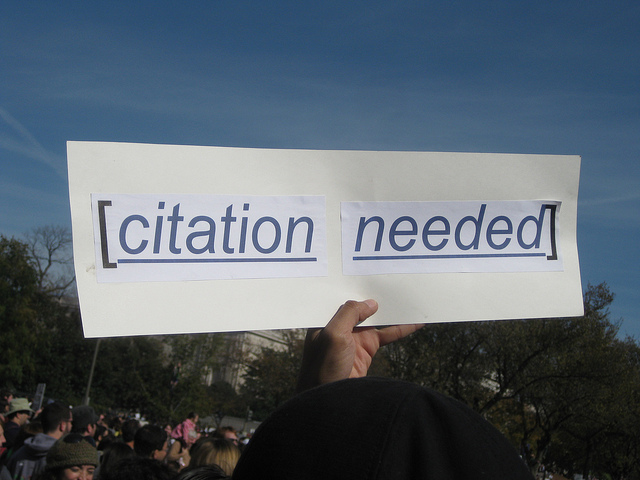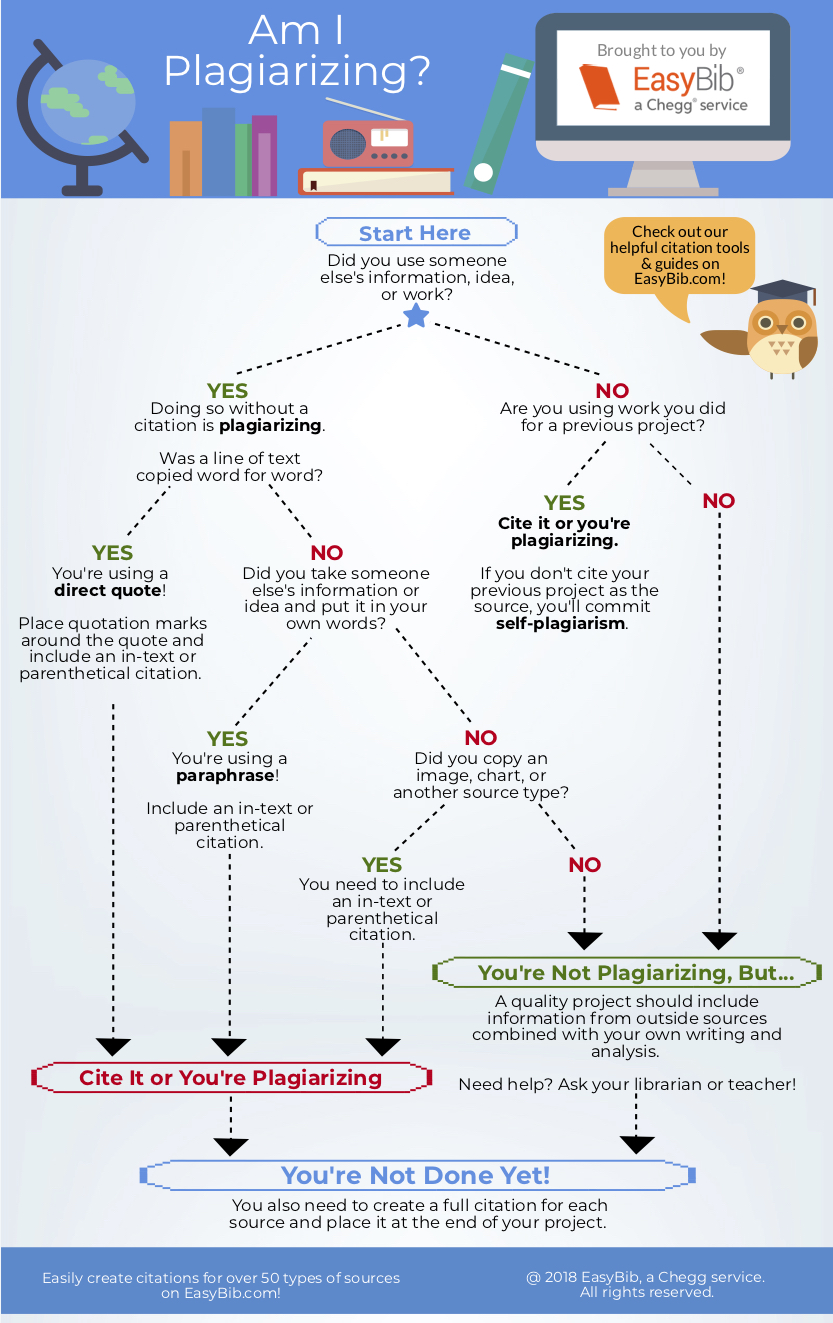
What is Plagiarism and How Can I Avoid It?
Plagiarism is fairly easy to avoid as long as you pay close attention to how you integrate your source material and make sure that you give credit to the source when using someone else’s words or ideas. There are two ways to use someone’s ideas: you may use them word for word (verbatim) as a quote, or you may paraphrase the idea in your own words. Either way, the original author should be credited for their words or ideas.
Plagiarism (sometimes called “literary theft”) is the presentation of someone else’s work as your own.
More formally stated, it is the act of claiming language, ideas, opinions, theories, software code, artistic material, or anything else developed by another person without acknowledging that person as the source of the material. Because of the ubiquity of information online and the ease with which we can cut and paste, it is very easy to commit plagiarism and not even be aware of doing so. But whether the plagiarism is intentional or unintentional, it is considered dishonest, unfair, and unethical.
There are serious consequences for both intentional and unintentional plagiarism. Ignorance is not an excuse. As a student, the consequences of plagiarism can range from the loss of credit for an assignment or course to expulsion from school. In the work world, the consequences of plagiarism can range from loss of your professional reputation and credibility to the loss of your job and the destruction of your career. As a student, you should be familiar with your school’s and/or instructors’ academic integrity policies.
Examples of Plagiarism
-
-
- Copying and pasting from a source into your work without attribution
- Purchasing a paper online or from another student
- Turning in the same work in two different classes (self-plagiarism)
- Failing to put quotation marks around direct quotes in your work
- Copying a diagram, image, graph, or photo into your work without referencing the source
- Copying and pasting text and changing just a few words or phrases to “put it into your own words,” sometimes referred to as patch writing
- Using information gained in a personal interview or conversation without citing the source
- Failing to cite sources for any information that you used in your paper
-
*Only information considered to be universally common knowledge, such as dates of important events and widely known facts, can be used without citing the source.
Credit must always be given to others for:
-
-
- their words, either quoted or paraphrased;
- their artistic material (photos, charts, slideshows, etc.); and
- their research findings, analysis, and conclusions.
-
The best way to avoid plagiarism is to simply list the sources you used in preparing your work (many writers find it helpful to jot down or bookmark all their sources as they find them and compose their drafts). You may not end up using all of your sources, but saving them as you work (even if you may not use some) will save you a lot of trouble down the road trying to track down a source you used and forgot to document.
Citing sources is the way you tell your audience whose works you used and to give credit to the creators of those works. It has the side benefit of providing your audience with a bibliography of relevant items on that topic in case they want to read further.
Figure 6.5.2 provides some helpful tips to determine if you are plagiarizing:

8 Simple Rules to Avoid Plagiarism
To avoid the plagiarism trap, here are 8 simple rules each researcher should follow:
CITE WHILE YOU WRITE
To avoid missing citations, make sure to insert citations while you are writing your paper. If you put your paper aside for a few days, you may forget where you found a particular piece of information or from where you copied a quote.
AVOID COPY-PASTING
Avoid copy-pasting from other papers. It is better you reproduce someone else’s idea in your own words (so called “paraphrasing”) and provide a citation to the original source. Alternatively, if you specifically want to quote the original author, immediately insert the quotation marks around text you copy-pasted, followed by the citation.
USE SHORT QUOTATIONS
Make sure you don’t quote entire paragraphs. Limit quotations to one or two key sentences. Further, limit the total number of quotations in your paper to just a few. Lots of quotations make your text harder to read.
ASK FOR PERMISSION FROM THE COPYRIGHT HOLDER
If you are copying small parts of a work, such as a short quote or a comment, and you are not sure if this falls under fair use, it is better to ask the copyright holder for a written permission.
COPYING IMAGES AND PHOTOS IS ALSO PLAGIARISM
Images and photos (or videos) are also copyrighted. If you wish to re-use someone else’s visuals in your own paper (for instance, in a review paper or in the methods section of a research paper), make sure you obtain written permission from the copyright holder. Many copyright holders will allow you to re-use given imagery if you properly cite and attribute the original source of the images, sometimes with a small fee. Follow the guidance of the copyright holder regarding the best wording to use for attribution.
APPLY THE SAME STANDARDS WHEN COPYING FROM OPEN ACCESS JOURNALS OR THE PUBLIC DOMAIN
If you re-use images or photos from open access journals, make sure to include the citation. If you quote from works that are available under an open access license or in the public domain (such as quoting from an author that is long deceased), you still have to use quotation marks and use a proper citation. While it would not be a copyright infringement to reproduce a work that is considered public domain, some readers might still consider it deceitful if you do not properly attribute the original author/work.
INFORM YOUR CO-AUTHORS
You may be asked to work collaboratively in your class or workplace. If so, it’s important to make sure that all your co-workers/collaborators are familiar with best practices to avoid plagiarism. If in doubt, have your paper checked by a plagiarism detection software before submitting.
AVOID SELF-PLAGIARISM
If you re-use your own previous work or imagery in new papers, this often leads to self-plagiarism. Usually, you give up copyright when transferring your work to a publisher so that self-plagiarism often constitutes a copyright infringement. In addition to possible copyright infringement, it is not good practice to re-publish material that is already available elsewhere.
For more information on how to avoid plagiarizing, watch “Citing Sources & Avoiding Plagiarism” from Madison College Libraries:
Additional Resources
- “Plagiarism: Avoid it at All Costs,” a helpful slideshow presentation on avoiding plagiarism.
- “Avoiding Plagiarism, Self-plagiarism, and Other Questionable Writing Practices: A Guide to Ethical Writing,” a comprehensive website from the Office of Research Integrity devoted entirely to avoiding plagiarism.
CHAPTER ATTRIBUTION INFORMATION"5.2 Plagiarism." Technical Writing. [License: CC BY 4.0] "Citation Help and Avoiding Plagiarism." Uploaded by Madison College Libraries, 28 July 2019, Youtube.com. REFERENCES"8 Simple Rules to Avoid Plagiarism." Ediqo.com. |

